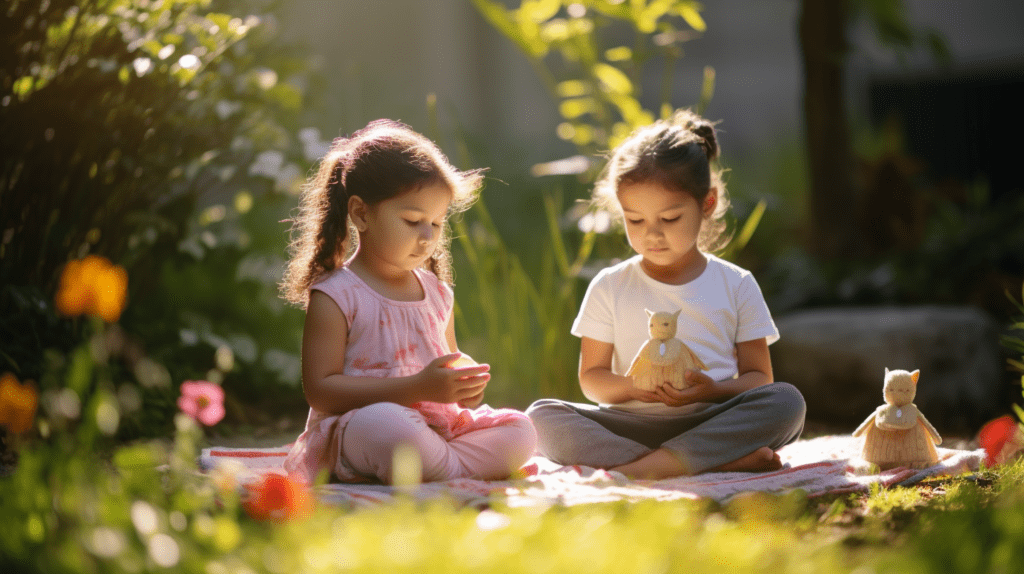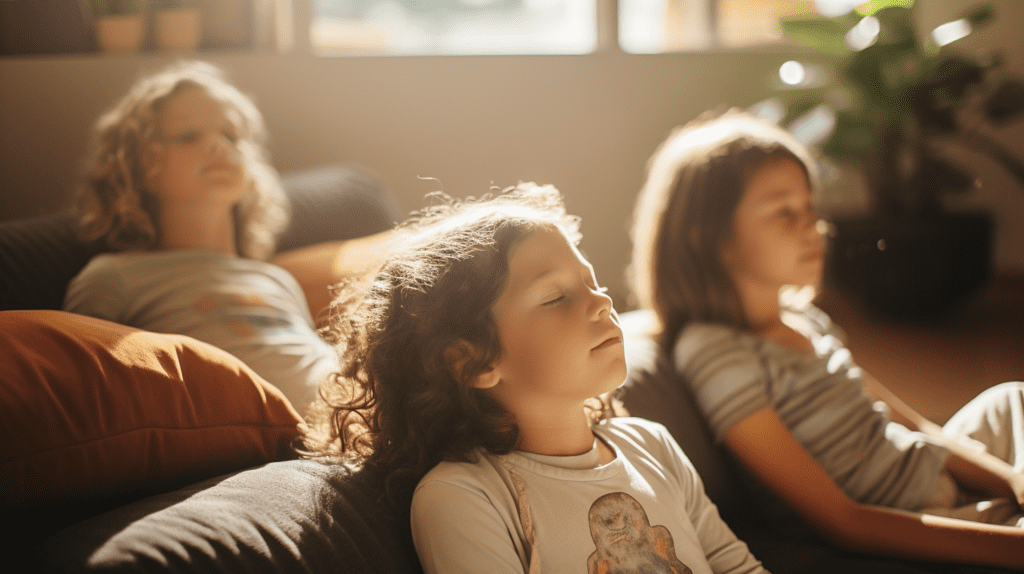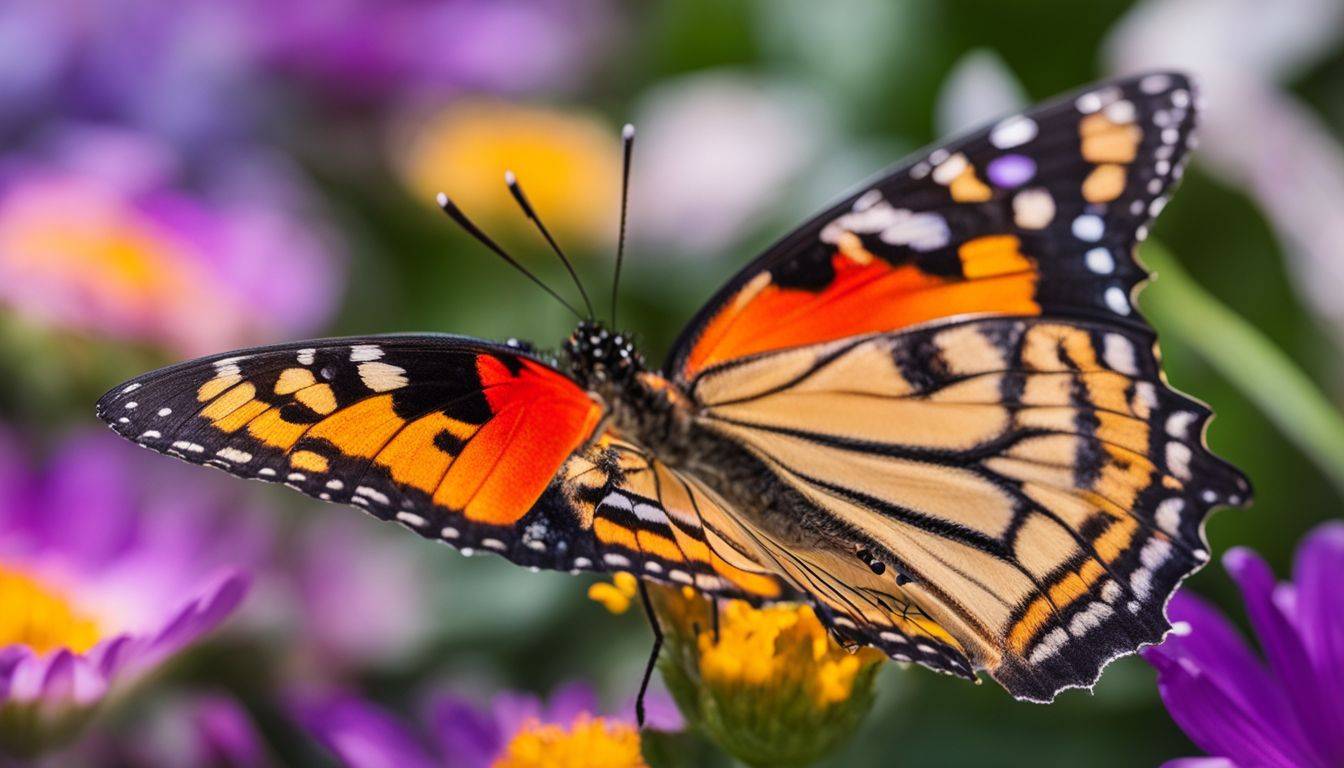Say Goodbye to Stressful Parenting: Try Meditation for Kids Today!

Meditation for Kids? Feeling anxious about how to ensure your child remains calm and focused in today’s fast-paced world?
Studies show that meditation can significantly improve children’s mood, attention span, and even lessen feelings of anxiety and depression.
This helpful guide will introduce you to kid-friendly meditation techniques, why they work, and steps to implementing them effectively at home. Interested?
Read on for a roadmap to starting this life-enhancing journey with your little ones!
Meditation for Kids, Key Takeaways
- Meditation can significantly improve children’s mood, attention span, and reduce feelings of anxiety and depression.
- Kids who meditate regularly exhibit improved attention spans compared to those who don’t meditate.
- Meditation helps children develop better emotional regulation and reduces impulsivity.
- Age – appropriate techniques like deep belly breathing or guided meditation can be introduced to kids as young as 3 or 4.
Benefits of Meditation for Children

Meditation helps children improve their focus and attention, reduces stress and anxiety, and enhances their emotional regulation.
Kids Improved focus and attention
Meditation can significantly boost your child’s ability to concentrate and maintain focus. Children, just like adults, live in a world filled with distractions and information overload.
A regular practice of meditation helps them tune out unwanted noise and enhances their attention span. Not only does this result in better performance at school tasks, but it also strengthens their cognitive abilities for life.
In fact, high school students who meditate regularly exhibit improved attention spans compared to those who don’t meditate. Making meditation a part of your child’s daily routine could be a game-changer, turning scattered thinking into focused understanding!
Reduced stress and anxiety

Meditation aids in the reduction of stress and anxiety for kids. It works by lowering cortisol levels – a hormone commonly associated with stress. Practicing simple mindfulness meditation helps children keep their worries at bay and improves mental resilience, allowing them to better handle stressful situations.
Furthermore, includes activities like yoga as part of your child’s daily routine can make a significant difference in their emotional wellbeing.
Yoga comes hand-in-hand with meditation, helping not just in physical fitness but also in easing anxiety and depression symptoms among children when compared to physical education alone.
Such benefits are essential for growing kids experiencing various changes physically and emotionally.
Enhanced emotional regulation of our Children

Meditation for kids goes beyond stress reduction. It plays a crucial role in enhancing emotional regulation, contributing to fewer meltdowns and reduced impulsivity among children.
Kids who regularly engage in meditation gain the ability to calm themselves down, understand their feelings better, and handle their emotions constructively.
Neuroscientists have discovered that regular mindfulness meditation exercises like guided imagery or body scan can help rewire the brain to manage stress better.
This means your child doesn’t just experience temporary peace during meditation but also benefits from long-term changes in how they react to stressful situations.
These positive changes are not possible without consistent practice; therefore, developing routine is essential.
How to Introduce Meditation to Kids

To introduce meditation to kids, it is important to choose age-appropriate techniques that they can easily understand and engage with.
Choosing age-appropriate techniques
When introducing meditation to children, it is important to choose techniques that are suitable for their age. Younger children may benefit from simple practices such as deep belly breathing or body movements, while older kids can engage in visualization exercises or loving-kindness meditation.
By tailoring the techniques to match their developmental level, your child will be more likely to stay engaged and enjoy the practice. Remember that children as young as 3 or 4 can start practicing guided meditation, so don’t hesitate to introduce them to this beneficial practice early on.
Creating a calm and inviting space

To create a calm and inviting space for meditation, it’s important to choose a quiet area that is free from distractions. Find a place in your home where your child can feel comfortable and relaxed.
This could be a corner of their bedroom or a dedicated spot in the living room. Set up cushions or blankets for them to sit on, creating a cozy environment that promotes relaxation.
Consider adding soft lighting and calming elements such as plants or gentle music to enhance the atmosphere. By creating this soothing space, you are providing an environment conducive to mindfulness and helping your child develop their meditation practice.
Using guided meditations or visualization exercises

Guided meditations and visualization exercises are effective tools for introducing meditation to children. Through guided meditations, an adult or guide uses soothing scripts and imagery to help kids relax and tune into their own thoughts and feelings.
Visualization exercises, on the other hand, encourage children to use their imagination to create a calming mental image during meditation.
These practices can be particularly useful for helping kids manage stress, anxiety, and difficult emotions by allowing them to tap into their natural process of self-observation.
By incorporating guided meditations and visualization exercises into your child’s routine, you can provide them with a valuable tool for finding peace and relaxation in their busy lives.
Fun and Engaging Meditation Practices for Kids

Kids can enjoy mindful breathing exercises, body scan meditation, guided imagery and storytelling, and loving-kindness meditation. Read more to discover these fun techniques!
Mindful breathing exercises
Mindful breathing exercises are a playful and effective way to introduce mindfulness to children. By engaging in simple breathing techniques, kids can learn how to focus their attention and regulate their emotions.
These exercises teach them the importance of being present in the moment and help reduce stress and anxiety. With practice, mindful breathing activities can improve concentration, promote relaxation, and enhance emotional well-being in children.
Whether it’s practicing belly breathing or pretending to be different animals with unique breathing patterns, these fun exercises provide valuable tools for kids to navigate their inner world with calmness and clarity.
Body scan meditation

Body scan meditation is a wonderful practice that helps children develop body awareness and emotional harmony. By bringing their attention to the present moment, body scan meditations promote calmness and relaxation in kids.
During these exercises, children are guided to scan their bodies for any pain, tension, or anything out of the ordinary. Incorporating body scans into daily routines can be an effective way to bring calmness and focus to your child’s day.
Not only are they a fun activity for building body awareness, but they also contribute to enhancing emotional well-being in children.
Guided imagery and storytelling

Guided imagery and storytelling are powerful tools to engage children in meditation practices. With guided imagery, children can create vivid images in their minds, helping them feel less anxious or nervous.
This technique uses visualization and imagination to reduce stress and pain, promoting emotional regulation and inner connections. By incorporating storytelling into guided imagery, meditation becomes even more enjoyable for kids.
Storytelling brings their imaginations to life, making the experience engaging and captivating. It has been used for centuries as a therapeutic technique to help children alleviate pain and stress.
Loving-kindness meditation

Loving-kindness meditation is a wonderful practice to teach children, as it helps strengthen bonds and encourage positive experiences. Research has shown that this type of meditation can reduce stress and anxiety in kids, while also increasing feelings of hope and decreasing stress.
By practicing loving-kindness meditation, children can cultivate kindness and compassion for themselves and others. It’s amazing how even just one session of this meditation can make kids feel less isolated and more connected to those around them.
Tips for Supporting Kids in their Meditation Practice

Encourage consistency and routine by setting aside a specific time each day for meditation.
Encouraging consistency and routine

Consistency and routine are key when it comes to encouraging kids in their meditation practice. By making meditation a regular part of their day, children can develop a habit and experience the full benefits of this calming practice.
Just like any skill, meditation requires practice and repetition to become easier over time. With daily sessions, children can gradually build their focus and attention skills, while also reducing stress and anxiety.
In order to support your child’s consistency with meditation, create a designated time and space for them to practice each day. This will help establish a sense of routine and make it easier for them to incorporate meditation into their daily lives.
Modelling mindfulness and consistent self-care habits yourself can also be extremely helpful in encouraging your child’s consistency with meditation. When children see you taking the time to meditate regularly, they are more likely to view it as an important activity that they should prioritize as well.
Additionally, providing gentle guidance and support along the way will help your child stay motivated in their journey towards becoming more mindful. Celebrate their progress by acknowledging their achievements and verbally recognizing how far they have come in developing these valuable skills.
Modeling mindfulness and meditation

Parents play a crucial role in teaching and guiding their children, and this applies to meditation as well. By modeling mindfulness and meditation practices themselves, parents can set a powerful example for their kids.
When children see their parents engaging in these activities regularly, it normalizes the practice and encourages them to do the same. Whether it’s finding moments of stillness throughout the day or incorporating mindful breathing exercises into daily routines, parents can show their children the importance of taking time for self-care.
This not only fosters a positive environment for mindfulness but also helps strengthen the parent-child bond through shared experiences.
Providing gentle guidance and support
Parents play a crucial role in supporting their children as they embark on their meditation journey. By providing gentle guidance and support, parents can help create a safe and nurturing environment for their kids to explore mindfulness.
This can include offering reassurance, answering questions about meditation techniques, and being present during meditation sessions to encourage focus and relaxation.
By demonstrating patience and understanding, parents can foster a sense of trust with their children, allowing them to feel more comfortable in their practice.
Through gentle guidance and support, parents can empower their kids to develop lifelong habits of mindfulness that will benefit them both now and in the future.
Celebrating progress and achievements
As parents, it’s important to celebrate our children’s progress and achievements in their meditation practice. Recognizing their efforts can go a long way in encouraging them to continue with their mindfulness journey.
Whether they’re able to sit quietly for a few minutes or successfully calm their minds during a guided meditation, these small victories should be acknowledged and praised. Celebrating their progress not only boosts their self-confidence but also reinforces the positive impact that meditation is having on their well-being.
By showing our support and appreciation, we can inspire them to keep exploring the benefits of mindfulness and find joy in each step of their meditation practice.
Conclusion

Meditation for kids offers many benefits, including improved focus, reduced stress, and enhanced emotional regulation. By introducing meditation techniques that are age-appropriate and creating a calm space, parents can help their children engage in this practice.
With consistent support and guidance, kids can develop mindfulness skills that will benefit them throughout their lives.
FAQs
1. What is meditation for kids?
Meditation for kids is a practice that helps children calm their minds, relax their bodies, and develop focus and mindfulness through breathing techniques and guided imagery.
2. How can meditation benefit kids?
Meditation can benefit kids by reducing stress, improving concentration and attention span, boosting self-esteem, promoting emotional regulation, and enhancing overall well-being.
3. Can anyone teach meditation to kids?
Yes, anyone can teach meditation to kids as long as they have a basic understanding of the practice and use age-appropriate techniques to engage children in mindful activities.
4. When should I introduce my child to meditation?
You can introduce your child to meditation at any age when they are able to sit still for a few minutes and follow simple instructions. Starting with short sessions and gradually increasing duration is recommended.
For More interesting reading
Disclaimer – About Us – Terms & Conditions – Contact Us – Privacy Policy
